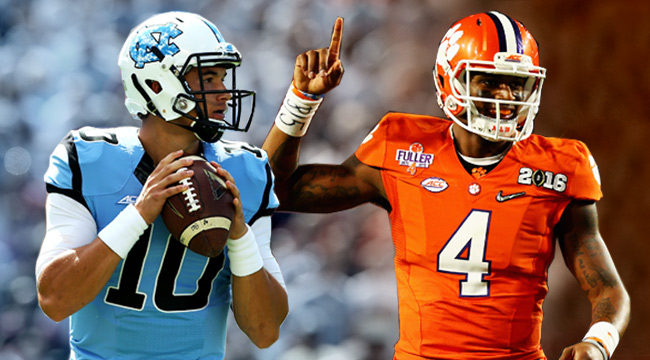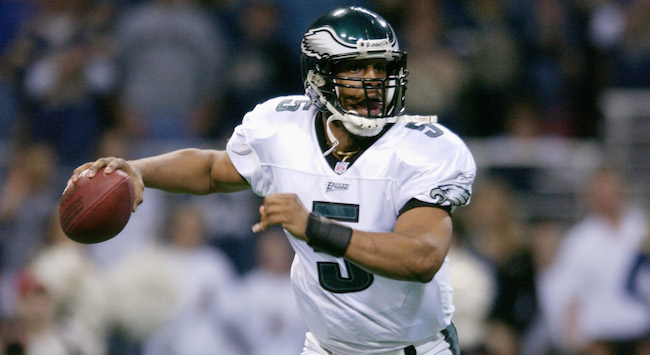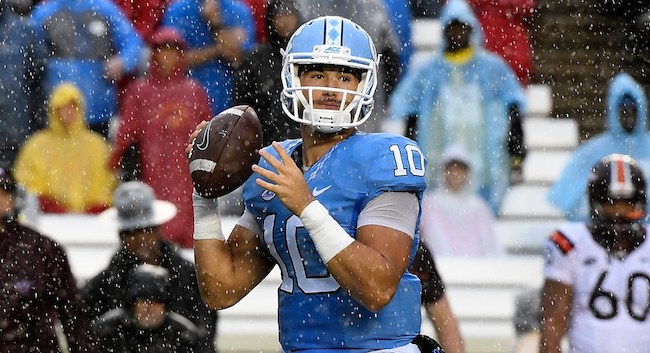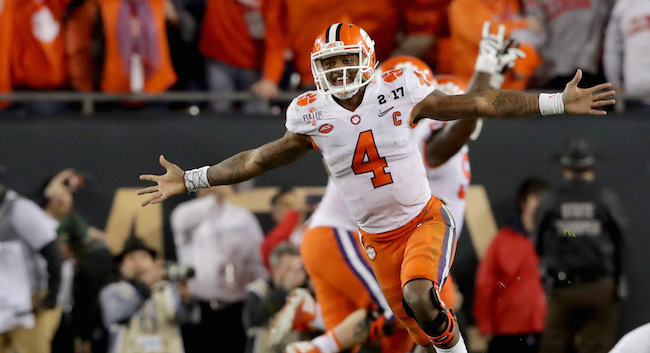
PHILADELPHIA – Three quarterbacks were taken with the first 12 picks of the 2017 NFL Draft, with all three teams trading up in order to select who they hope will be their franchise quarterback of the future. Mitch Trubisky (Bears, No. 2), Patrick Mahomes (Chiefs, No. 10), and Deshaun Watson (Texans, No. 12) all come into the league facing immense pressure in very different situations.
Trubisky will sit a year on a bad Bears team behind Mike Glennon — signed this offseason to a 1-year deal — before being the presumptive starter in 2018, if not given a chance late in 2017. Mahomes comes into a playoff team from a year ago and will sit behind Alex Smith, who has two more seasons left on his contract, but there is an out clause prior to 2018. Watson also joins a playoff team, but he will battle for the starting job immediately with Brandon Weeden and Tom Savage.
These three quarterbacks — along with other early round picks like DeShone Kizer of the Browns — now face one of the toughest challenges in pro sports, the transition to being an NFL quarterback. A new system with new verbiage awaits them at rookie camp, along with a faster game and tighter throwing windows. There’s only so much a quarterback can do on his own to get ready for this new challenge, and the fit between the quarterback and their new coaching staff and team culture has so much to do with how successful they can be.
Speaking with former Eagles quarterback Donovan McNabb, the No. 5 overall pick in 1999, prior to Thursday night’s first round, we discussed what goes in to making a good fit for these quarterbacks and how teams and coaches must adapt to their new quarterback as much as the quarterback adapts to the team in order to be successful.

“It’s about the fit,” McNabb says. “If you’re drafted in the early picks, your team’s not that good. You’re probably not going to have a good team for a couple of years. But fit, meaning, you’ve got to have a good coaching staff — the offensive coordinator, quarterback coach — how can I teach this kid and get him ready to play from the pocket, and then if things break down make plays for us? I think that’s something a lot of people don’t focus on. We can talk about the mobility of guys, we can talk about how smart a guy is, because some guys ‘well, he’s really smart’ but he stinks. We keep praising him because he’s really smart and he got all this on the Wonderlic test. Who cares? Put a helmet on, play football.”
Fit can mean everything for a quarterback, and it can ultimately be the determining factor between whether a guy is a success or a failure in the league, well beyond what his own talent indicates. For McNabb, it goes both ways though, and the team itself has to fit its offense to the talent they spent an early pick on.
“The best fit is the offense that you run and how can you cater that around his strengths. Because I think coaches get so enamored by the offense that we run and ‘oh, we’ve been so successful.’ Like, you haven’t been that successful unless you’re New England. And the thing is, you have to cater to the quarterback and then build with that. Build with what his strengths are and continue to teach him and prepare him, if he’s not a 3-step, 5-step, 7-step drop whatever, run what he’s comfortable with but still teach him to play from that pocket. That way when he’s in year 4, year 5, year 6, he’s at that elite level playing from the pocket and still has the ability to make plays.”
McNabb was at the draft to help FedEx present $5,000 donations to the USO on behalf of the Air & Ground Players of the draft, the first quarterback and running back taken on Thursday night. Trubisky, at No. 2, was that quarterback, and he heads into a situation where he will face a challenge he’s never truly faced — losing.

Trubisky was a four-star recruit out of high school, with 53 total touchdowns passing and rushing his senior season. He went to North Carolina where he famously started only 13 games, going 8-5, which while not exceptional, is still a winning record. Now, he goes to a team that went 3-13 a year ago, and has significant talent needs across the board.
Quarterback was one of those positions, but the process of building the Bears back up is just beginning. As McNabb says, that adjustment and learning how to see positives and incremental improvements by yourself and the team in the midst of losing is one of the hardest for a young quarterback.
“It’s hard because most guys that get drafted have come from winning teams,” McNabb says. “Now you’re going to a team that stinks. You’re so used to battling with guys that are probably first and second round with you, and you go to a team with guys and you remember playing him in college and he was pretty good and you can’t put things together. And it’s like, why can’t we put it together, we’re better than what we’re showing? Well, it takes time and you have to build that chemistry and over time it starts to come together. Then you start to see the end result.”
And change can’t happen overnight. Pulling the plug on a rebuild, or not giving it the appropriate amount of time, could hurt a growing quarterback way more than it helps. If anything, McNabb stresses “The Process” just as much as Philly fans.
“Everyone becomes so impatient and wants it to happen now,” McNabb says. “And fans are the same way. It’s like, just relax. It’s a process. Just like here [in Philadelphia] with the Sixers, it’s a process. All of a sudden you get Joel Embiid, he looks great. You get your other rookie and it’s like, what are we missing? A point guard. You’re missing a scoring two guard. There’s pieces over time that once that happens it’s like, oh we’re pretty good.”
Most of the focus when a player gets drafted is on the physical tools. His ability to make “all of the throws” is a favorite line among scouts and draft pundits, or his touch on the deep ball and ability to squeeze the ball through tight windows in the middle of the field. There’s also talk of the mental side of the game, but usually from the standpoint of intelligence and whether he can comprehend a complex offense or make the necessary reads on the field.
However, there’s a mental toughness aspect that is impossible to measure until they’re in the situation. As McNabb told us, understanding that you won’t come in and be perfect is the hardest thing for young quarterbacks to adjust to.

“Understanding that you’re not perfect,” McNabb says on advice he’d give a rookie quarterback. “As a rookie coming in, you want to shine and show I can play and all of a sudden you’re forcing balls, getting picked off, not reading your right keys. You’re rushing yourself instead of allowing the game to come to you. So for me, I think sitting down and being able to prepare them for things aren’t going to be as great as how you think they’re going to be, but don’t get frustrated. The big thing is, you hear so much, it’s not as bad as it looks.”
That’s where coaching and game film can really help. And not letting outside noise or criticism break down a guy’s confidence, especially if the problems are fixable on tape.
“You know a guy may go out and the ball goes in the dirt or he overthrows a guy, ball gets picked,” McNabb says. “Then you go back and watch the film and say ‘what did you do wrong.’ And it’s, oh, my left foot, or I didn’t step into the throw, I kinda faded back. ‘Why did it go high?’ Cause my left shoulder, gotta bring it down. ‘Why’d you throw the pick?’ Because I forced it. And then all of a sudden you look and, hey, the tight end’s open. ‘What number was that in the read?’ Number 2. ‘Well why’d you go from 1 to three and skip 2?’ Those are things you can clean up. If a kid goes out and looks awful and he’s reading the right things and not throwing it, that’s something that’s like, what’s wrong?”
No player is going to understand that on their own and need a supportive environment around them in order to grow comfortable with making mistakes, but ensuring that they are going to learn from them. That starts with the coaching staff and the fit of quarterback, coordinator, and system. For the three teams that traded up in order to land a quarterback in this draft, you would expect that they would understand that. That they went up to get the quarterback they felt fits them the best and that they can tailor what they do to enhance that quarterback’s abilities to the highest level.
We’ll find out over the next four years if they follow through on that plan, or, if like so many teams that run on the treadmill of mediocrity, they insist on trying to fit a square peg into a round hole. If they’re drafting a quarterback in the first round again by 2020, they’ve probably done the latter.






